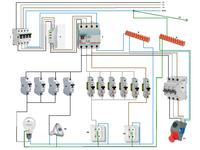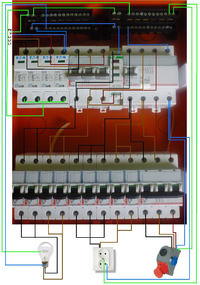Hello. I would like to make an electrical installation at my cottage. I made such a preliminary diagram and I would like a specialist to say whether such connections will be correct.
Under the conditions of the connection, the power engineer wrote that the installation was to be made in the TN-CS system, and the power engineer would make the connection through an overhead line in the TN-C system.
As I mentioned in the post about grounding, I will try to achieve a resistance of 10Ohm. All this will be checked by a licensed electrician, but I would like to do the entire installation and all connections myself.
1- main switch
2- phase indicator lights
3- residual current circuit breaker 40A 30mA
4- N cable strip
5- grounding strip
6- fuse B10
7- fuse B10 - about 10 bulbs will be connected to fuses 6,7,8
8- fuse B10
9- fuse B10 - 12 halogens will be connected to the fuse
10- fuse B16
11- fuse B16
12- fuse B16
13- fuse B16 - no more than 4 sockets will be connected to the fuses 10, 11, 12, 13, 14 on the line (the sockets will be connected with a loop. The wire will come out of the fuse, go around the room and return back to the box)
14- fuse B16
15- fuse B16 - connection of 3 sockets to a hydrophore, a furnace with a feeder and a boiler
16- fuse D25 - connection of the socket to the force
17- lighting about 10 40W bulbs
18- lighting about 12 halogens
19- sockets - no more than 4 pcs. Per line
20- sockets in the boiler room
21- force socket
I am asking for an opinion whether such installation will be functional. Is it possible to connect a second residual current circuit breaker to this system only under force and where to connect it and where to connect a surge protector? (The house does not have a lightning protection system)
The lighting is on YDYp 3x1.5mm cables
Sockets on YDYp 3x2.5mm
Power socket on YDYp 5x2.5mm
The earth electrode will be made on a 16mm wire

Under the conditions of the connection, the power engineer wrote that the installation was to be made in the TN-CS system, and the power engineer would make the connection through an overhead line in the TN-C system.
As I mentioned in the post about grounding, I will try to achieve a resistance of 10Ohm. All this will be checked by a licensed electrician, but I would like to do the entire installation and all connections myself.
1- main switch
2- phase indicator lights
3- residual current circuit breaker 40A 30mA
4- N cable strip
5- grounding strip
6- fuse B10
7- fuse B10 - about 10 bulbs will be connected to fuses 6,7,8
8- fuse B10
9- fuse B10 - 12 halogens will be connected to the fuse
10- fuse B16
11- fuse B16
12- fuse B16
13- fuse B16 - no more than 4 sockets will be connected to the fuses 10, 11, 12, 13, 14 on the line (the sockets will be connected with a loop. The wire will come out of the fuse, go around the room and return back to the box)
14- fuse B16
15- fuse B16 - connection of 3 sockets to a hydrophore, a furnace with a feeder and a boiler
16- fuse D25 - connection of the socket to the force
17- lighting about 10 40W bulbs
18- lighting about 12 halogens
19- sockets - no more than 4 pcs. Per line
20- sockets in the boiler room
21- force socket
I am asking for an opinion whether such installation will be functional. Is it possible to connect a second residual current circuit breaker to this system only under force and where to connect it and where to connect a surge protector? (The house does not have a lightning protection system)
The lighting is on YDYp 3x1.5mm cables
Sockets on YDYp 3x2.5mm
Power socket on YDYp 5x2.5mm
The earth electrode will be made on a 16mm wire





